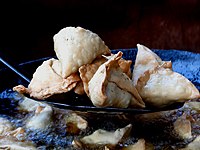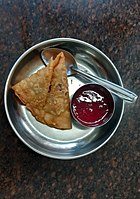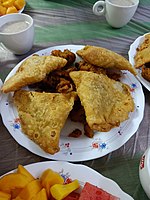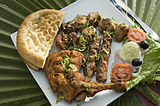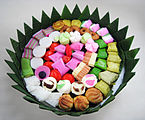Samosa: Difference between revisions
No edit summary |
|||
| Line 26: | Line 26: | ||
The South Asian samosa is believed to be derived from a medieval precursor from [[the Middle East]] that was [[baked]] and not [[deep fried]]. The earliest mention of a samosa precursor was by [[Abbasid Caliphate|Abbasid]]-era poet [[Ishaq al-Mawsili]], praising the ''sanbusaj''. Recipes are found in 10th–13th-century Arab cookery books, under the names ''sanbusak'', ''sanbusaq'', and ''sanbusaj'', all deriving from the Persian word {{transliteration|fa|sanbosag}}. In [[Iran]], the dish was popular until the 16th century, but by the 20th century its popularity was restricted to certain provinces (such as the {{transliteration|lrl|sambusas}} of Larestan). [[Abolfazl Beyhaqi]] (995–1077), an [[Iranian peoples|Iranian]] historian, mentioned it in his history, ''[[Tarikh-e Beyhaghi]]''. | The South Asian samosa is believed to be derived from a medieval precursor from [[the Middle East]] that was [[baked]] and not [[deep fried]]. The earliest mention of a samosa precursor was by [[Abbasid Caliphate|Abbasid]]-era poet [[Ishaq al-Mawsili]], praising the ''sanbusaj''. Recipes are found in 10th–13th-century Arab cookery books, under the names ''sanbusak'', ''sanbusaq'', and ''sanbusaj'', all deriving from the Persian word {{transliteration|fa|sanbosag}}. In [[Iran]], the dish was popular until the 16th century, but by the 20th century its popularity was restricted to certain provinces (such as the {{transliteration|lrl|sambusas}} of Larestan). [[Abolfazl Beyhaqi]] (995–1077), an [[Iranian peoples|Iranian]] historian, mentioned it in his history, ''[[Tarikh-e Beyhaghi]]''. | ||
The Central Asian ''[[samsa (food)|samsa]]'' was introduced to the Indian subcontinent in the 13th or 14th century by chefs from the Middle East and Central Asia who cooked in the royal kitchens for the rulers of the [[Delhi Sultanate]]. [[Amir Khusro]] (1253–1325), a scholar and the royal poet of the Delhi Sultanate, wrote around 1300 CE that the princes and nobles enjoyed the "samosa prepared from meat, [[ghee]], onion, and so on". [[Ibn Battuta]], a 14th-century traveler and explorer, describes a meal at the court of [[Muhammad bin Tughluq]], where the ''samushak'' or ''sambusak'', a small pie stuffed with minced meat, almonds, pistachios, walnuts and spices, was served before the third course of ''[[Pilaf|pulao]]''. ''[[Nimatnama-i-Nasiruddin-Shahi]]'', a [[medieval India]]n cookbook started for [[Ghiyath Shah]], the ruler of the [[Malwa Sultanate]] in central India, mentions the art of making samosa. | The Central Asian ''[[samsa (food)|samsa]]'' was introduced to the Indian subcontinent in the 13th or 14th century by chefs from the Middle East and Central Asia who cooked in the royal kitchens for the rulers of the [[Delhi Sultanate]]. [[Amir Khusro]] (1253–1325), a scholar and the royal poet of the Delhi Sultanate, wrote around 1300 CE that the princes and nobles enjoyed the "samosa prepared from meat, [[ghee]], onion, and so on". [[Ibn Battuta]], a 14th-century traveler and explorer, describes a meal at the court of [[Muhammad bin Tughluq]], where the ''samushak'' or ''sambusak'', a small pie stuffed with minced meat, almonds, pistachios, walnuts and spices, was served before the third course of ''[[Pilaf|pulao]]''. ''[[Nimatnama-i-Nasiruddin-Shahi]]'', a [[medieval India]]n cookbook started for [[Ghiyath Shah]], the ruler of the [[Malwa Sultanate]] in central India, mentions the art of making samosa. The ''[[Ain-i-Akbari]]'', a 16th-century [[Mughal Empire|Mughal]] document, mentions the recipe for [[qottab]], which it says, "the people of [[Hindustan]] call ''sanbúsah''". | ||
The samosa gained its popularity due to its savory flavor and convenience. The pocket-sized food item was a readily available [[snack]] for workers and travelers across Central and South Asia. | The samosa gained its popularity due to its savory flavor and convenience. The pocket-sized food item was a readily available [[snack]] for workers and travelers across Central and South Asia. | ||
Revision as of 15:18, 9 August 2025
 Samosas with chutney | |
| Alternative names | sambusa, samusa, siṅgaṛā/siṅāṛā, samose |
|---|---|
| Type | Savoury pastry |
| Course | Entrée, side dish, snack |
| Place of origin | Middle East |
| Region or state | South Asia, West Asia, East Africa, Central Asia, Southeast Asia |
| Serving temperature | Hot |
| Main ingredients | Flour, vegetables (e.g. potatoes, onions, peas, lentils), spices, chili peppers, mince, and cheese |
A samosa (/səˈmoʊsə/) (![]() listen (help·info)) (Hindi: समोसा) ( Persian: سمبوسه) is a fried South Asian and West Asian snack. It is a pastry with a savory filling that mostly consists of vegetables like spiced potatoes, onions, and peas, but can also include meat or fish, or even cheese. Its name originates from the Middle Persian word sambosag (سنبوسگ) (meaning 'triangular pastry'). It is made in different shapes, including triangular, cone, or crescent, depending on the region. Samosas are often accompanied by chutney, and have origins in medieval times or earlier. Sweet versions are also made. Samosas are a popular entrée, appetizer, or snack in the cuisines of South Asia, Southeast Asia, West Asia, Central Asia, Portugal, East Africa and their South Asian diasporas.
listen (help·info)) (Hindi: समोसा) ( Persian: سمبوسه) is a fried South Asian and West Asian snack. It is a pastry with a savory filling that mostly consists of vegetables like spiced potatoes, onions, and peas, but can also include meat or fish, or even cheese. Its name originates from the Middle Persian word sambosag (سنبوسگ) (meaning 'triangular pastry'). It is made in different shapes, including triangular, cone, or crescent, depending on the region. Samosas are often accompanied by chutney, and have origins in medieval times or earlier. Sweet versions are also made. Samosas are a popular entrée, appetizer, or snack in the cuisines of South Asia, Southeast Asia, West Asia, Central Asia, Portugal, East Africa and their South Asian diasporas.
Etymology
The English word samosa derives from the Hindustani word samosa (Urdu: سموسہ, Hindi: समोसा), traceable to the Middle Persian word sambōsag (سنبوسگ) 'triangular pastry'. Similar pastries are called sambusak in Arabic from Persian; medieval Arabic recipe books sometimes spell it sambusaj, which are all borrowed from Persian sanbosag.
History


The South Asian samosa is believed to be derived from a medieval precursor from the Middle East that was baked and not deep fried. The earliest mention of a samosa precursor was by Abbasid-era poet Ishaq al-Mawsili, praising the sanbusaj. Recipes are found in 10th–13th-century Arab cookery books, under the names sanbusak, sanbusaq, and sanbusaj, all deriving from the Persian word sanbosag. In Iran, the dish was popular until the 16th century, but by the 20th century its popularity was restricted to certain provinces (such as the sambusas of Larestan). Abolfazl Beyhaqi (995–1077), an Iranian historian, mentioned it in his history, Tarikh-e Beyhaghi.
The Central Asian samsa was introduced to the Indian subcontinent in the 13th or 14th century by chefs from the Middle East and Central Asia who cooked in the royal kitchens for the rulers of the Delhi Sultanate. Amir Khusro (1253–1325), a scholar and the royal poet of the Delhi Sultanate, wrote around 1300 CE that the princes and nobles enjoyed the "samosa prepared from meat, ghee, onion, and so on". Ibn Battuta, a 14th-century traveler and explorer, describes a meal at the court of Muhammad bin Tughluq, where the samushak or sambusak, a small pie stuffed with minced meat, almonds, pistachios, walnuts and spices, was served before the third course of pulao. Nimatnama-i-Nasiruddin-Shahi, a medieval Indian cookbook started for Ghiyath Shah, the ruler of the Malwa Sultanate in central India, mentions the art of making samosa. The Ain-i-Akbari, a 16th-century Mughal document, mentions the recipe for qottab, which it says, "the people of Hindustan call sanbúsah".
The samosa gained its popularity due to its savory flavor and convenience. The pocket-sized food item was a readily available snack for workers and travelers across Central and South Asia.
Regional varieties
India
The samosa is prepared with an all-purpose flour (locally known as maida) and stuffed with a filling, often a mixture of diced and cooked or mashed boiled potatoes, onions, green peas, lentils, ginger, spices and green chillies. A samosa can be either vegetarian or non-vegetarian, depending on the filling. The entire pastry is deep-fried in vegetable oil or (rarely) ghee until it achieves a golden-brown colour. It is served hot, often with fresh green chutneys, such as mint or coriander chutney, or tamarind chutney. It can also be prepared in a sweet form. Samosas are often served as a tea-time snack, or as a chaat (a type of street food), along with the traditional accompaniments of either a chickpea or a white pea preparation, drizzled with yogurt, tamarind chutney and green chutney, and garnished with chopped onions, coriander, and chaat masala.
In the Indian states of Assam, Odisha, West Bengal, Bihar and Jharkhand, singaras (সিঙ্গারা) or shingras (চিংৰা) (the East Indian version of samosas) are popular snacks found almost everywhere. They are a bit smaller than in other parts of India, with a filling consisting chiefly of cooked diced potato, peanuts, and sometimes raisins. Shingras are wrapped in a thin sheet of dough (made of all-purpose flour) and fried. Good shingras are distinguished by flaky textures akin to that of a savory pie crust.
Singaras may be eaten as a tea-time snack. They can also be prepared in a sweet form. Bengali singaras tend to be triangular, filled with potato, peas, onions, diced almonds, or other vegetables, and are more heavily fried and crunchier than other singaras or their samosa cousins. Singara filled with cauliflower mixture is a popular variation. Non-vegetarian varieties of singaras are mutton singaras and fish singaras. There are also sweet versions, such as coconut singara, as well as others filled with khoya and dipped in sugar syrup that are known as Mishti Shingara.
In the city of Hyderabad, a smaller version of samosa with a thicker pastry crust and minced meat filling, referred to as lukhmi, is consumed, as is another variation with an onion filling. Crispy samosas filled with a spicy onion filling are also popular in the city and known as Irani/onion samosas. They were popularised by Irani cafes in the city and are also popularly sold in train stations and bus stands.
In the states of Andhra Pradesh, Karnataka, Kerala, and Tamil Nadu, samosas are slightly different, being folded differently, more like Portuguese chamuças, with a different style of pastry. The filling also differs, typically featuring mashed potatoes with spices, fried onions, peas, carrots, cabbage, curry leaves, and green chilis, and is mostly eaten without chutney. Samosas in South India are made in different sizes, whose fillings are influenced by local food habits, and may include meat.
-
Samosas before being fried, at a sweet shop in Kolkata.
-
Samosas in India
-
Samosa with tomato ketchup available at Indian coffee houses in Kerala
-
Vegetable samosa
-
Vegetable samosa
Bangladesh

Both flat-shaped (triangular) and full-shaped (tetrahedron/triangular pyramid) samosas are popular snacks in Bangladesh. A Bengali version of the full-shaped samosa is called a সিঙাড়া (shingara) and is normally smaller than the standard variety. The shingara is usually filled with pieced potatoes, vegetables, nuts, etc. However, shingaras filled with beef liver are very popular in some parts of the country. The flat-shaped samosa is called a somosa or somucha, and is usually filled with onions and minced meat.
Nepal
Samosas are called singadas in the eastern part of Nepal; the rest of the country calls it samosa. In Nepal, samosa was introduced to by the Indian merchants and communities who migrated to Nepal, such as the Marwari people, and it quickly became a very popular snack. Instead of chuntey as popular in the neighbouring countries, samosa is often served and consumed with a chickpea or green pea curried soup. Vendors sell the dish in various markets and restaurants.
Pakistan
Samosas of various types are available throughout Pakistan. In general, most samosa varieties sold in the southern Sindh province and in the eastern Punjab, especially the city of Lahore, are spicier and mostly contain vegetable or potato-based fillings. However, the samosas sold in the west and north of the country mostly contain minced meat-based fillings and are comparatively less spicy. The meat samosa contains minced meat (lamb, beef, or chicken) and is popular as a snack food in Pakistan.
In Pakistan, the samosas of Karachi are famous for their spicy flavour, whereas samosas from Faisalabad are noted for being unusually large. Another distinct variety of samosa, available in Karachi, is called kaghazi samosa (Urdu: کاغذی سموسہ; "paper samosa" in English) due to its thin and crispy covering, which resembles a wonton or spring roll wrapper. Another variant, popular in Punjab, consists of samosas with side dishes of mashed spiced chickpeas, onions, and coriander leaf salad, as well as various chutneys to top the samosas. Sweet samosas are also sold in the cities of Pakistan including Peshawar; these sweet samosas contain no filling and are dipped in thick sugar syrup.
Another Pakistani snack food, popular in Punjab, is known as samosa chaat. This is a combination of a crumbled samosa, along with spiced chickpeas (channa chaat), yogurt, and chutneys. Alternatively, the samosa can be eaten on its own with chutney on the side.
In Pakistan, samosas are a staple iftar food for many Pakistani families during the month of Ramzan.
Maldives
The types and varieties of samosa made in Maldivian cuisine are known as bajiyaa. They are filled with a mixture including fish like tuna and onions.
Similar snacks
Template:More citations needed section Similar snacks and variants of samosas are found in many other countries. They are derived either from the South Asian somasa or are derived from the medieval precursor that originated in the Middle East.
Central Asia
The samsa is a savoury pastry in Central Asian cuisines, consisting of a bun stuffed with meat and sometimes vegetables.
Southeast Asia
Myanmar (Burma)

Samosas are called samuza (စမူဆာ) in Burmese, and are an extremely popular street snack in Burma. Samosas are also used in a traditional Burmese salad called samuza thoke (စမူဆာသုပ်; lit. 'samosa salad'), a salad of cut samosa pieces with onions, cabbage, fresh mint, light potato and chickpea curry broth, masala, chili powder, salt and lime.
Indonesia

In Indonesia, samosas are locally known as samosa, filled with potato, cheese, curry, rousong or noodles as adapted to local taste. They are usually served as a snack with sambal. Samosa is similar to Indonesian pastel, panada and epok-epok.
Africa
East Africa
Samosas are also a key part of East African food often seen in Somalia, Tanzania, Kenya, Uganda, Burundi, Eritrea, Ethiopia, and Rwanda. In much of East Africa, samosa is called "sambusa" (Tigrinya and Amharic: ሳምቡሳ "sāmbusā," Somali: sambuus, Swahili: sambusa, Arabic: سمبوسة "sambusa")
Samosas, locally called samoussas, are a popular snack on Réunion and Mauritius as both islands have faced large waves of labor immigration from the Indian subcontinent. The samosas there are generally smaller and filled with chicken, cheese, crabs or potatoes. There are also varieties such as chocolate and banana or pizza.
The variety of samosa made in Somali cuisine is filled with ground beef or vegetables, along with usually being blended with Somali spices. Sambusa is often consumed during Ramadan. Samosas are also a staple of local cuisine in the fellow Horn of Africa countries of Djibouti and Ethiopia.

South Africa
Called samoosas in South Africa, they tend to be smaller than Indian variants, and form part of South African Indian and Cape Malay cuisine.
West Africa
Samosas also exist in West African countries such as Ghana and Nigeria, where they are a common street food. In Nigeria, it is usually served in parties along with chicken or beef, puff puff, spring rolls and plantains and are called small chops.
Middle East
Arab countries

Sambousek (Arabic: سمبوسك) are usually filled with either meat, onion, pine nuts, za’atar, spinach dock, or cheese.
Iran

Sambuseh (Persian: سمبوسه) can often be found in the southern regions of Iran and rarely in other areas. However, traditionally it used to be made in the form of qottab filled with ground nuts (usually, walnuts), sugar, fragrant herbs or spices, and likewise fried in oil. It is used as a confectionary and quite commonly. When meat is used, it is no longer called qottab. This is all that remains of the old "sanbusag" in its ancient homeland. Nowadays, Iranian Sambuseh is often made with a sausage and pizza cheese based filling; however, a vegetable-based variety also exists.
Israel
Sambusak (Hebrew: סמבוסק) comes in several distinct forms, as sambusak has been influenced differently by Sephardic and Mizrahi cuisine. Sephardi sambusak is generally thicker, baked, and stuffed with either cheese or beef and coated with sesame or nigella seeds. Mizrahi sambusak is generally thinner, larger, fried, and stuffed with curry-spiced chickpea and onion, and is usually not coated with seeds.
Portuguese-speaking regions
In Goa (India), Portugal, and Angola, samosas are known as chamuças. They are usually filled with chicken, beef, pork, lamb or vegetables, and generally served quite hot. Samosas are an integral part of Goan and Portuguese cuisine, where they are a common snack.
-
Goan chamuças
-
Portuguese chamuças in a café in Ponta Delgada
-
Angolan chamuças
English-speaking regions
Samosas are popular in the United Kingdom, Australia, New Zealand, Trinidad and Tobago, Barbados, Guyana, Uganda, South Africa, Rwanda, Kenya and Tanzania, and are also growing in popularity in Canada and the United States. They may be called samboosa or sambusac, but in South Africa, they are often called samoosa. Frozen samosas are increasingly available from grocery stores in Australia, Canada, the United States, and the United Kingdom, where they are also frequently sold fresh by local Indian and Pakistani street market vendors.
Variations using filo, or flour tortillas are sometimes found.
Al-Shabaab's samosa ban
Al-Shabaab, the extremist group controlling parts of Somalia, banned samosas in 2011 over concerns about the possible use of rotten meat in the filling.
See also
External links
| この記事は、クリエイティブ・コモンズ・表示・継承ライセンス3.0のもとで公表されたウィキペディアの項目Samosa(2 August 2025, at 05:13編集記事参照)を素材として二次利用しています。 Item:Q22658 |
- Pages using Sister project links with hidden wikidata
- Pastries
- Central Asian cuisine
- Bangladeshi fast food
- Bangladeshi snack foods
- Indian snack foods
- Indonesian snack foods
- Middle Eastern cuisine
- Sephardi Jewish cuisine
- Stuffed dishes
- Kashmiri cuisine
- Burmese cuisine
- Goan cuisine
- Pakistani fast food
- Pakistani snack foods
- Indian fast food
- Somali cuisine
- Maldivian cuisine
- Malaysian cuisine
- Singaporean cuisine
- Nepalese cuisine
- Portuguese cuisine
- Cuisine of Odisha
- Iranian pastries
- South African cuisine
- Eritrean cuisine
- Ethiopian cuisine
- Kenyan cuisine
- Djiboutian cuisine
- Deep fried foods
- Tajik cuisine
- South Asian cuisine
- North Indian cuisine
- South Indian cuisine
- Dumplings
- Arab pastries
- Bangladeshi cuisine
- Pakistani cuisine
- Indo-Caribbean cuisine
- Barbadian cuisine
- Fijian cuisine
- Israeli pastries

